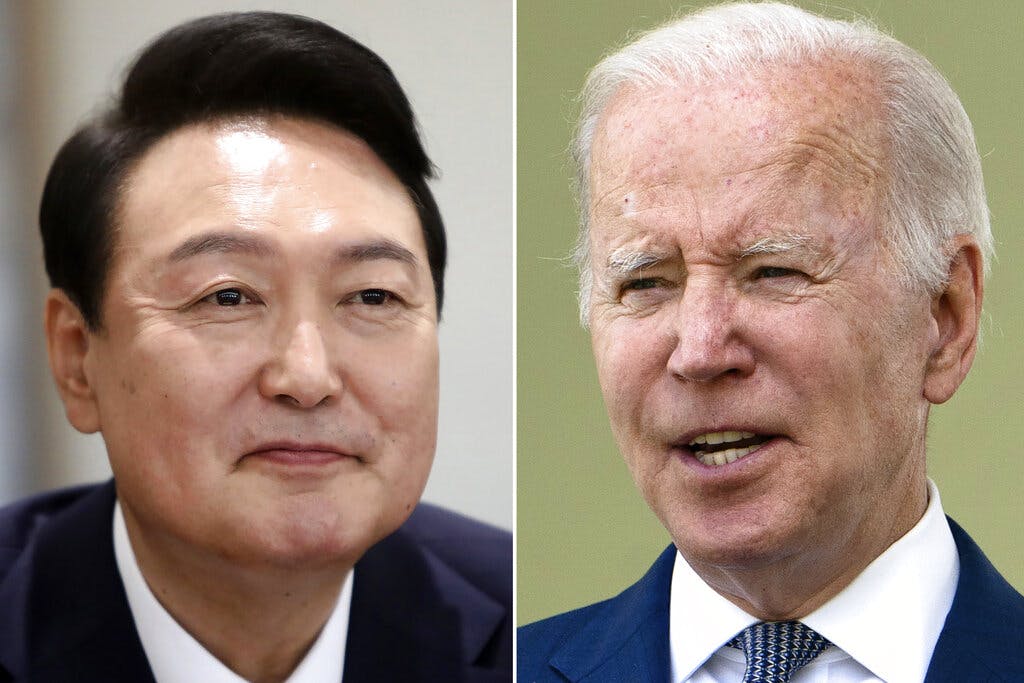South Korea, Emerging as Major International Arms Exporter, Weighs Supplying Ukraine — at Risk of Offending Russia and Communist China
The question is at the forefront as South Korea’s president meets with Biden this week at Washington.

The South Koreans are up to their necks in the war in Ukraine regardless of whether they know it — or like it.
The scenario is relatively simple: We don’t ship arms to Ukraine, South Korea can say — that’s against our policy of arming a country at war, and it also would upset the Russians, with whom we would like to remain on decent terms.
Yet how about shipping ammunition, not the actual weapons, to another country, which will then be able to ship more of its own stockpile to the country at war? And what about exporting the wizardry needed to make modern weapons work to another country, which then manufactures them for export?
Those are two of the ways that South Korea is aiding the Ukrainians against the Russians. South Korea’s president, Yoon Suk-yeol, when he meets President Biden for their summit at the White House on Wednesday, will be able to look him in the eye and say he’s doing what he can, even though he would rather not declare South Korea as that much on Ukraine’s side.
“There is no doubt that the United States is pushing the South Koreans to provide significant supplies of weapons, particularly artillery ammunition to Ukraine,” a lecturer on East Asia studies at Stanford with extensive background in the region, Daniel Sneider, said.
“It is a pragmatic reality that there are serious shortfalls of ammunition, artillery, and armor that are crucial to the defense of Ukraine, and South Korea is a potentially major source of NATO-standard weapons.”
The South Koreans, as Mr. Sneider told the Sun, “have responded by supplying indirectly via Poland.” Meanwhile, he noted, “the Biden administration and the Yoon administration are clearly searching for a way to overcome that obstacle and provide supplies directly to Ukraine.”
Messrs. Yoon and Biden may not come up with a definitive solution to that riddle in their meeting this week, but Mr. Yoon’s top security adviser, Cho Tae-yong, and his deputy have been at Washington for more than a week looking for ways to work out an understanding with the Americans on a wide range of issues.
No, Mr. Yoon won’t be expecting Mr. Biden to agree on South Korea’s emergence as a nuclear power by making nukes of its own to match those the North has been producing for years. Nor is he going to plant American nukes on bases in the South, from which President George H.W. Bush pulled them in 1991 thinking maybe, just maybe, North Korea would stop trying to fabricate nuclear warheads, one of which the North exploded for the first time in 2006.
Yet he’s going to want reassurance of American military support for South Korea in the face of unending threats from North Korea, and they should go beyond the cliches of an “ironclad relationship” with “no daylight between us.”
Nor will it suffice to say that it’s now the 70th anniversary year of the signing of the Korean War armistice on July 27, 1953, and the 70th anniversary of the formal alliance between America and the Republic of Korea, South Korea.
The phrase du jour is “extended deterrence,” which on closer look may not go beyond just plain deterrence, but we’re bound to hear it a lot over the next few days. Mr. Biden will assure Mr. Yoon that America’s full military might — in the form of nuclear warheads — will be poised to respond if Mr. Kim dares go beyond rhetoric and turn threats into reality.
America’s enemies — and South Korea’s enemies, too — are the two major powers that came to North Korea’s rescue in the Korean War, stopped American and South Korean forces from unifying North and South, and have been supporting North Korea militarily, economically, and diplomatically ever since.
American and South Korean worries about whatever Communist China and Russia are likely to do for North Korea will come up in the talks. Just as the South Koreans do not want to offend Russia, so they are reluctant to upset China by joining in any commitment to the defense of the island democracy of Taiwan.
China, after all, is pumping oil and food into North Korea and presumably is capable of pressuring North Korea’s leader, Kim Jong-un, into not ordering what would be the North’s seventh nuclear test, its first since 2017. Americans, while sensitive to South Korea’s predicament, would like to see a show of firm support against both Moscow and Beijing.
“During the war, Soviet fighter pilots flew against U.S. pilots in planes marked as North Korean aircraft,” an ex-Army officer in South Korea, Steve Tharp, who has worked as a civilian with the U.S. command, said. “The pilots were speaking Russian, which was clearly intercepted by our side. The U.S. and the Soviets were each country’s enemy.”
Times have not changed all that much despite Russia’s transition to non-communist authoritarian rule. Russia “is still the enemy of South Korea and the U.S.,” Mr. Tharp told the Sun. “The South Koreans see a need to help Ukraine, another victim of Russian aggression, as was South Korea in 1950 by the Soviet Union.”
As those sentiments shine through the interaction between Americans and Koreans, the quid pro quo will be clear. South Korea must get creative about ways to aid Ukraine without saying flat out it’s aiding Ukraine.
Times have changed since the Korean War. South Korea could inundate Ukraine with arms if given a face-saving way to do it.
“South Korea is on the way to joining the ranks of major arms exporters as Russian aggression in Ukraine triggers a global race for arms acquisition,” a one-time correspondent for the authoritative Far Eastern Economic Review, Shim Jae-hoon, writes for the Asia Sentinel.
“As Big Power arms suppliers like Russia and China temporarily recede from arms bazaars in Europe and Asia, South Korea is filling the gap with medium-level technology arms like K2 Black Panther tanks, K9 self-propelled howitzers, Javelin-type multiple launch rockets, and FA50 supersonic light combat fighters,” Mr. Shim notes. “It is a significant development for a country that has long depended on the U.S. for most of its heavy weapons.”
Incredibly, one way South Korea is pitching in is to return to America half a million 155-millimeter artillery shells that the Americans sent years ago to South Korea. The Americans will then have all the shells they need — and can begin feeding them to Ukraine.
Yet what about making actual end-user weapons for Ukraine? The South Koreans are coming close by selling the chassis of howitzers to a Polish factory, which gets the turrets from Britain, the 155-millimeter cannons from France, and fire control systems from another Polish manufacturer.
Might Mr. Yoon come close to simply telling Mr. Biden, “We’re now ready to send arms and ammunition directly to Poland”?
Probably not, but “the issue has become a part of the intense partisan battles inside South Korea,” Mr. Sneider said. “The leaks regarding American surveillance of South Korea have fed the accusation that the Yoon government is merely responding to American arm-twisting.”
Korean policymakers understand that this is not just about managing the visit to Washington, Mr. Sneider says. As he has argued in talks in Seoul, “the outcome of the war will shape the situation in the region, and it is in South Korea’s national interest that Russian aggression be defeated clearly.”
For those reasons, “not just for summitry,” he said, “I expect South Korea to move soon to supply vital weapons directly to Ukraine.”

